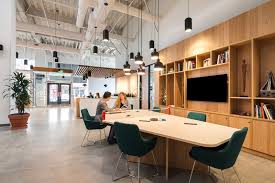Exploring the Transformative Power of Living Spaces

The Importance of Spaces in Our Lives
Spaces play a crucial role in shaping our experiences, emotions, and interactions. From the comfort of our homes to the bustling energy of urban environments, the spaces we inhabit have a profound impact on our well-being and quality of life.
At home, our living spaces serve as sanctuaries where we seek solace, relaxation, and connection with loved ones. A well-designed living room can foster warmth and intimacy, while a cluttered and chaotic space may induce stress and anxiety. The layout, lighting, colours, and furniture arrangement all contribute to creating a harmonious environment that supports our daily activities and nurtures our relationships.
Public spaces, such as parks, plazas, and community centres, provide opportunities for social interaction, recreation, and cultural exchange. These shared spaces are essential for building a sense of community and belonging. They offer a place for people to gather, celebrate events, exercise outdoors, or simply enjoy nature’s beauty.
Workspaces also play a significant role in influencing productivity, creativity, and overall job satisfaction. An office with ample natural light, ergonomic furniture, and collaborative areas can boost employee morale and engagement. On the other hand, a cramped cubicle with poor ventilation may hinder performance and well-being.
Moreover, the design of urban spaces can shape the way we move through cities and experience their vibrancy. Pedestrian-friendly streetscapes encourage walking and cycling, reduce traffic congestion, and promote social interactions among residents. Well-planned public transport hubs facilitate seamless connectivity between different neighbourhoods and enhance accessibility for all members of society.
In conclusion, spaces are not just physical entities but dynamic environments that influence our behaviour, emotions, and connections with others. By recognising the importance of well-designed spaces in our lives – be it at home or in public – we can create environments that support human flourishing and foster a sense of harmony within communities.
Maximising Your Space: Five Essential Tips for Improved Movement, Storage, and Functionality
- Ensure there is adequate space for movement in crowded areas.
- Make use of storage solutions to maximise space in small rooms.
- Create separate spaces for different activities to improve productivity.
- Consider the flow of spaces when designing a layout for better functionality.
- Utilise natural light to make spaces feel more open and inviting.
Ensure there is adequate space for movement in crowded areas.
It is essential to ensure that there is sufficient space for movement in crowded areas to promote safety, comfort, and efficiency. In environments where people gather in large numbers, such as public events, transportation hubs, or shopping centres, having adequate space for movement can prevent congestion, reduce the risk of accidents, and enhance the overall experience for everyone. By allowing for smooth flow of pedestrian traffic and providing enough room for people to navigate freely, we can create a more pleasant and accessible environment that caters to the needs of individuals moving through the space.
Make use of storage solutions to maximise space in small rooms.
Utilizing storage solutions is a smart way to optimise space in compact rooms. By incorporating clever storage options such as wall-mounted shelves, under-bed drawers, and multi-functional furniture pieces, you can effectively declutter and organise the room while creating a more spacious and visually appealing environment. Maximising vertical space and making use of hidden storage compartments help maintain a sense of openness and functionality in small rooms, enabling you to make the most out of every inch available.
Create separate spaces for different activities to improve productivity.
Creating separate spaces for different activities can significantly enhance productivity. By designating specific areas for work, relaxation, and socialising, individuals can better focus on the task at hand without distractions. A dedicated workspace can promote concentration and efficiency, while a cosy corner for relaxation can help recharge the mind and reduce stress. By compartmentalising activities into distinct spaces, individuals can create a conducive environment that supports their workflow and enhances overall productivity throughout the day.
Consider the flow of spaces when designing a layout for better functionality.
When designing a layout, it is essential to consider the flow of spaces to enhance functionality. By carefully planning how different areas connect and interact with each other, you can create a seamless and efficient environment that supports the activities and needs of its users. A well-thought-out spatial flow can improve circulation, promote natural movement patterns, and enhance the overall user experience. Whether it’s a home, office, or public space, prioritising the flow of spaces in your design can lead to more functional and harmonious environments.
Utilise natural light to make spaces feel more open and inviting.
Utilising natural light in a space is a simple yet effective way to create an open and inviting atmosphere. Natural light not only illuminates the area but also enhances the overall ambience, making the space feel more spacious and welcoming. By maximising the use of natural light through strategically placed windows, skylights, or glass doors, you can bring warmth and brightness into the room, creating a connection with the outdoors and improving the well-being of occupants. The play of sunlight throughout the day can transform the mood of a space, making it feel airy, vibrant, and uplifting.
